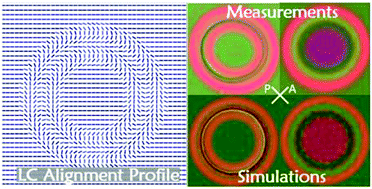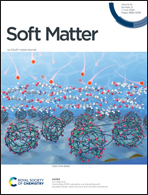Ring-shaped liquid crystal structures through patterned planar photo-alignment†
Abstract
Patterned liquid crystal (LC) configurations find widespread applications in functional devices such as lenses, gratings, displays and soft-robots. In combination with external stimuli such as an applied electric field, photo-alignment at the surfaces offers an attractive way to stabilize different LC structures in the bulk of a device. Herein, a planar LC cell is developed using a photo-alignment layer at the bottom substrate and a rubbed nylon film at the top substrate. Patterned planar photo-alignment is achieved by modulating the linear polarization with a spatial light modulator (SLM) and projecting the pattern onto the bottom substrate. A ring pattern is written into the photo-alignment layer with a continuous rotation between an inner radius and an outer radius. In the other regions the alignment is parallel to the rubbing direction at the top substrate. Four different LC configurations are observed: structure A in which a ring-shaped region is formed with an out of plane (vertical) orientation perpendicular to the substrate, structure B which has a single disclination loop and a 180° twist at the inner region of the photo-patterned ring (r < rin), structure C which has no discontinuities but a 360° twist in the inner region of the photo-patterned ring (r < rin) and structure D with 2 disclination loops. The LC director configuration for all 4 structures is simulated through finite element (FE) Q-tensor simulations and the optical transmission for each structure is simulated using a generalized beam propagation method.



 Please wait while we load your content...
Please wait while we load your content...